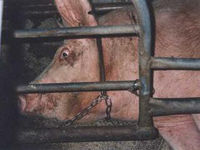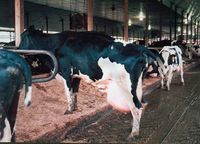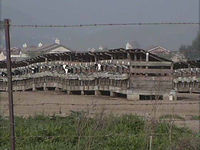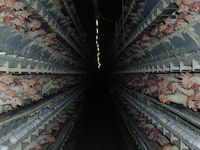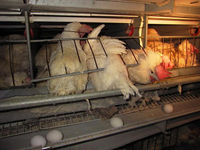Meat & Dairy industry
Meat & dairy industry focuses on U.S. based, global animal agribusiness and its impact on trade, health and the environment. For government subsidies, see also U.S. Government's War on Animals. For animal rights and welfare issues, see also animals raised & hunted for food.
Contents
- 1 Overview
- 2 Advertising & media
- 3 Top meat, dairy & egg companies & purchasers
- 4 CAFOs, meat processing & health issues
- 4.1 Working in & living near animal factories
- 4.2 Food borne illnesses
- 4.3 Antibiotics & hormones
- 4.4 EU ban on hormones & imports from U.S./Canada
- 4.5 Waste products fed to farm animals
- 4.6 Mad cow disease
- 4.7 Avian flu & leucosis (chicken cancer)
- 4.8 Swine flu & pneumonia in factory farmed pigs
- 4.9 International (outsourcing & Swine flu)
- 5 Independent reports
- 6 Animal products & health issues
- 7 Political contributions
- 8 Articles & resources
Overview
Americans eat approximately 8 ounces of meat per day (about twice the global average). The U.S. slaughters approximately 10 billion animals a year or over 15% of the world's total (for 5% of the population). However, global demand has also multiplied in recent years due to rising affluence and Confined animal Feeding Operations (CAFO)s or factory farms. These "animal factories" consume vast amounts of energy, generate pollution and environmental damage. They require increasing amounts of corn, soy and grains which has led to wide spread destruction of rain forests. [1]
Between 1940 and 2007, the average amount of milk produced per cow rose from 2 to 10 tons per year. [2] In 2006, the U.S. dairy industry produced over 20 billion gallons of milk. [3] With the rise of technology at the end of the 19th century, dairy production from a regional to a nationwide industry. [4], [5] The need for such for an increase in milk production has been questioned, since the dairy industry has been overproducing for 60 years. Between the years 1986 and 1987, dairy farmers were paid over 1.3 billion dollars to slaughter their cows. 144 dairy producers received over one million apiece to refrain from dairy farming for five years (one California producer received 20 million dollars). However, according to the General Accounting Office (GAO), "Total milk production did not decrease because nonparticipating farmers increased their production". [6]
Advertising & media
Got milk? & milk mustache ad campaigns
The Got Milk? ad campaign was created in 1993 by Goodby, Silverstein & Partners for the California Milk Processor Board, following a 20 year slump in sales. The slogan has been licensed to dairy boards across the United States since 1995. Got milk? has also been licensed to a range of consumer goods; including toys, teen apparel and kitchenware. [7] Goodby, Silverstein & Partners is a subsidiary of the Omnicom Group, the world's third largest advertising conglomerate.
One such dairy board is Dairy Management Inc., whose former campaigns include Milk. It does a body good. Heading up the DMI effort is Jeanne Sowa, a registered dietitian. Ms. Sowa previously worked for the National Cattlemen's Beef Association (NCBA) and was the coordinator of the Beef. It's what's for dinner ad campaign. Her DMI advertising budget is $106 million annually, which includes $42.4 million for milk and 18 million for cheese advertising. In contrast to Got Milk?, which is primarily marketed to children, the Milk Mustache campaign is aimed at young mothers and twenty-somethings. "What is a registered dietitian doing in charge of a $106 million dollar campaign to promote a product which causes a variety of health problems?" Dairy producers and affiliated companies spent $216 million on national advertising in 1996 (not including regional and local media outlets). [8]
USDA, HHS's product promotion & conflicts of interest
Got milk? was licensed to the National Milk Processor Board (MilkPEP) in 1998 to use in their celebrity print ads. [9], [10] This board was established by the U.S. Department of Agriculture's (USDA) Fluid Milk Promotion Act of 1990, to promote increased demands for fluid milk products. [11]
The milk mustache campaign [12] began in 1996 with a budget of $110 million, which increased to $190 million in 1998. The force behind the campaign is National Milk Processor Board (Fluid Board) which is administered by the USDA. While the USDA does incur some administrative costs, these are supposed to be reimbursed by industry. The promotional activity consists of generic advertising and a smaller amount funneled into "research and educational activities". Ads have featured the Secretary of Department of Health and Human Services (HHS), Donna Shalala and even President Clinton in major magazines. According to an HHS spokesperson defending the ad against consumer groups, "no money was accepted and no ethics rules were breached". However, the same government agency charged with educating Americans about healthy eating is also promoting industry interests. It was considered a coup for the industry for the highest ranking government health official to endorse their product for free. In 1996, the USDA Economic Research Service reported that generic advertising raised fluid milk sales by approximately one billion pounds (4.4 %) between September of 1993 and August of 1994. [13]
The milk police
In the fall of 1996, award-winning investigative journalists Steve Wilson and Jane Akre were hired by WTVT in Tampa, Florida to produce a series on rBGH. After over a year's work and three days before the series was scheduled to air, Fox News executives received the first of two letters from Monsanto's lawyers. According to the letters, Monsanto would suffer "enormous damage" if the series ran. The second letter warned of "dire consequences" of the series was aired as it stood. (How Monsanto knew what was in the series, remains a mystery.) WTVT had been advertising the series aggressively, but canceled it at the last moment. According to Florida Court records, Fox's lawyers then attempted to water down the series, twice offering to pay the journalists to leave the station and keep quiet about what had been done to their work. The reporters refused and filed a lawsuit against WTVT on April 2, 1998.
The lawsuit charged that WTVT violated its license from the Federal Communications Commission (FCC), by demanding that the journalists include known falsehoods in the rBGH series. They also charged that WTVT violated Florida's whistle blower law. On three separate occasions, Fox attempted to have the case summarily dismissed. However, after a five-week trial and six hours of deliberation ending on August 18, 2000, the jury unanimously determined that Fox "acted intentionally and deliberately to falsify or distort the plaintiffs' news reporting on BGH." They also found that Jane's threat to blow the whistle on Fox to the FCC, was the sole reason for their termination. She was awarded $425,000 in damages. On February 14, 2003, after six rejections by three different judges, Fox finally managed to win an appeal. [14], [15]
Top meat, dairy & egg companies & purchasers
Tyson Foods became the world's largest poultry and red meat provider after buying Iowa Beef Processors, Inc. (IBP) in 2001. [16] Tyson controls 27% of all meat and poultry sales in the U.S. One out of every four pounds of chicken, beef and pork consumed in the U.S. is a Tyson product. [17] Smithfield Foods is the world's largest pork producer. Smithfield is the largest pig farming operation in the U.S. and a major producer abroad. Smithfield controls 26% of the U.S. pork market, raising 14 million pigs at it's facilities and killing 27 million of the 60 million that went to slaughter in 2006. [18] Cargill is the second largest meat processing company in the U.S., after Tyson Foods. It is the second largest supplier of animal feed in the world. [19]
Willmar Poultry Company is the largest turkey producer in the U.S. It produces over 45 million turkey poults (young birds) annually at its two hatcheries in Minnesota. The Willmar hatchery is the largest turkey hatchery in the industry and delivers over 600,000 poults weekly to customers. [20] Cal-Maine Foods is the largest egg producer in the U.S. In fiscal 2009, Cal-Maine sold approximately 778 million dozen shell eggs, representing approximately 18% of domestic shell egg consumption. The company's approximately 27 million laying hens and 6 million pullets and breeders is the largest concentration of chickens in the U.S.[21]
Nestle is the world's leading producer of dairy products.[22] Dean Foods is the leading producer of fluid milk and dairy products in the United States and the second largest dairy company in the world. Dean Foods is second only to Nestle in terms of global dairy sales. [23]
McDonalds is largest purchaser of beef and the second largest purchaser of poultry in the U.S. [24]
Organizations that support CAFOs
Organizations that support CAFOs include member organizations of the Animal Industry Foundation; the American Veal Association, National Cattlemen's Beef Association, National Chicken Council, National Milk Producers Council, National Pork Producers Council, National Turkey Federation, United Egg Producers, U.S. Poultry and Egg Association and the American Feed Industry Association. [25] Also member organizations of the American Meat Institute, the Meat Promotion Coalition, the American Farm Bureau Federation and the National Dairy Council. Other industry-funded organizations which support CAFO's include the American Veterinary Medical Association (AVMA), the National Animal Interest Alliance (NAIA) and the Animal Welfare Council (AWC). See also processed food industry.
CAFOs, meat processing & health issues
Working in & living near animal factories
As many as 70 % of workers on CAFOs experience acute bronchitis and 25% contract chronic bronchitis. In one study, a number of other respiratory ailments were linked to working in indoor swine facilities for two hours a day over a period of six years. Some gases produced are fatal in high concentrations. In the U.S., at least 12 cases were documented over five years of workers dying from asphyxiation in manure pits.[26]
Residents of communities near hog farms also have increased respiratory problems. Studies have also shown a higher incidence of fatigue, depression and mood disturbances. A study in a Utah town found a four fold increase in diarrhea related hospitalizations and a three fold increase in respiratory related hospitalizations over a five years. During this time an industrial hog farm was constructed and started operating. Minnesota's Pollution Control Agency documented hydrogen sulfide concentrations in excess of World Health Organization (WHO) maximum exposure standards in areas near hog facilities. A 2006 study for two rural Iowa elementary schools, found a significant increase in asthma in children attending school near the CAFO.[27]
Food borne illnesses
Due to factory farm and slaughterhouse methods; there are risks of food borne illness in virtually all U.S. meats, dairy products and eggs. There are currently no requirements for testing for food borne illnesses due to lobbying by the meat and dairy industries. Cows are raised in huge feed lots the size of cities and become smeared with fecal matter and other filth. Slaughterhouse workers are under pressure to work at an ever increasing pace, sometimes being forced to kill and gut as many as 330 animals an hour. [28]
E. Coli bacteria can be found in up to 50% of U.S. cattle carcasses. [29] It has been estimated that 70% of of store brought chickens contain harmful bacteria. [30] and 90% of turkeys. [31]
Campylobacter is the leading cause of food-borne illness in the U.S. with the primary source being contaminated chicken flesh. Chicken warehouses may contain 50,000 birds. Antibiotics also make them vulnerable to disease as strains of bacteria become resistant. Approximately 5,000 people a day contract Campylobacter food poisoning every day in the U.S. Chickens in the U.S. are frequently infected with Salmonella, unlike European countries where livestock are treated more humanely and given more space, resulting in better health and fewer pathogens. According to Mitchell Cohen, M.D. of the Centers for Disease Control (CDC), there are outbreaks of Salmonella related to almost every animal product, including poultry, beef, pork, eggs and dairy products.
Instead of addressing and correcting factory farm conditions which encourage disease, the U.S. meat industry uses irradiation or nuclear radiation to kill pathogens. [32]
Antibiotics & hormones
In 2001, the Union of Concerned Scientists (UCS) announced that antibiotics in factory farms account for the overwhelming majority of all antibiotic use in the country. Dr. Margaret Mellon, is author of the UCS's report on anti-biotic use in livestock and the director of their food and environment program. According to Dr. Mellon, her group "did not oppose using antibiotics to treat sick animals, but that it did oppose their use for promoting growth or preventing infections in healthy animals." According her report, U.S. livestock producers use about 24.6 million pounds of antibiotics annually for "nontherapeutic" purposes (growth promotion and disease prevention) as opposed to treatment of disease. The nontherapeutic total includes about 10.3 million pounds in hogs, 10.5 million pounds in poultry and 3.7 million pounds in cattle. By contrast, humans use approximately 3 millions pounds of antibiotics annually in the U.S. Figures from the report showed much higher figures for animals and much smaller figures for humans, than industry generated reports. [33] The UCS reports that antibiotics administered to livestock are approximately eight times the amount administered to people for illnesses. [34]
Over 90% of beef cattle in the U.S. receive hormones and in larger feedlots the figure is 100%, according to the NCBA. [35] The Food and Drug Administration (FDA) approved the use of recombinant bovine growth hormone (rbGH) being injected into cows on February 4th, 1994. Both Europe and Canada turned down Monsanto's application for rBGH approval. Developed and manufactured by Monsanto, this genetically engineered hormone forces cows to artificially increase milk production by 10 to 15 %. [36] Monsanto spent approximately half a billion dollars on a hormone to increase milk production (for an already glutted, taxpayer-subsidized market). Additionally, Posilac creates additional Growth Factor One (IGF-1) in milk (a growth hormone which is identical in cows and humans). IGF-1 is considered to be a fuel cell for cancer growth and has been identified in the rapid growth cancer. [37] Additionally, cows injected with rBGH also have a 25% increase in udder infections and a 50% increase in lameness. [38] Cows do not adapt well to high milk yields or their high grain diets. Metabolic disorders and infertility problems are also common. [39] According to Dr. Michael Hanson of the Consumers Union of the U.S., there is strong scientific evidence to support potential health hazards of rBGH and a case for labeling dairy products that contain rBGH. [40] See also FDA.
EU ban on hormones & imports from U.S./Canada
Since 1995, the European Union (EU) has prohibited the treatment of any farm animals with sex hormones, which includes a ban on hormone treated meat from the U.S. and Canada. The U.S. asserts that that hormone-treated meat is safe because "sex hormones only promote human cancers in hormone-sensitive tissues, such as the female breast and uterus". According to the U.S. there is a "threshold" for acceptable levels of hormones and U.S. agriculture is well regulated so as not to exceed them. [41] However, according to a 136 page report compiled by an EU scientific committee, [42] hormones are carcenogenic due to interference with DNA. Therefore, there is no safe threshold (except zero). [43] See also EU.
Waste products fed to farm animals
The FDA finally banned the practice of feeding cow meat and bone meal back to cows in 1997 (after the Mad cow disease epidemic in Great Britain). However, dried poultry waste and sewage sludge are routinely fed to cattle. Pigs and chickens are still routinely fed the bones, brains, meat scraps, feathers, and feces of their own species. Furthermore, tens of millions of shelter animals are also picked up by rendering plants. Thus commercial meat, dairy, and egg products often come from animals whose diet included the ground up remains of cats and dogs, including the euthanasia drugs injected into their bodies. [44] 40 billion pounds a year of slaughterhouse wastes (blood, bone, viscera) and euthanized cats and dogs from veterinarians and animal shelters, are rendered annually into livestock feed. [45] Moreover, the FDA has been using inaccurate, incomplete, and unreliable data to track and oversee feed ban compliance. [46], [47]
Mad cow disease
In 1996, in response to the revelation that young people in Britain were dying from variant Creutzfeldt-Jakob Disease (vCJD), the human equivalent of Mad cow disease, the World Health Organization (WHO) issued seven recommendations. [48] Numbers 5-7 were recommendations for further research and 1-4 were concrete recommendations. The United States continues to violate all four guide lines; number one being to stop feeding animals to other other. [49] See also WHO.
High risk meat products
In December of 2003 on NBC Today, USDA Secretary Ann M. Veneman insisted:
- "all scientific evidence would show, based upon what we know about this disease, that muscle cuts -- that is, the meat of the animal itself -- should not cause any risk to human health." [50]
However, according to a 2002 report from the GAO, products such as beef stock, beef extract and beef flavoring are frequently made from boiled skeletal remains (including the vertebral column) of the carcass. [51] Spinal cord contamination may also be found in hot dogs, hamburgers, pizza toppings and taco fillings. [52] According to a 2002 USDA survey of high risk meat products, approximately 35% contained central nervous system tissues. [53],[54]
Avian flu & leucosis (chicken cancer)
According to a United Nations (UN) report, avian flu can be traced to filthy, crowded, disease ridden factory farm conditions. [55] It has been estimated that in some chicken flocks; 90% are infected with chicken cancer (leukosis). [56]
Swine flu & pneumonia in factory farmed pigs
Due to dust, irritating fumes, toxic gases and bacteria build up in over crowded warehouses, most factory farmed pigs have respiratory distress (which also effects workers). Seventy to 80 % of U.S. pigs have pneumonia at the time of slaughter. Water routinely given to U.S. pigs is liquid wastes draining from manure pits. [57] See also Swine flu & Smithfield Foods.
International (outsourcing & Swine flu)
See also Smithfield Foods, section 6.
Independent reports
A report released on November 19, 2006 by the UN's Food & Agriculture Organization (FAO) entitled Live Stock's Long Shadow, determined that livestock generates 18% of greenhouse gas (GHG) emissions; more than all transportation (cars, trucks, ships and planes) combined. It was also found to be a major source of environmental damage.
- "Livestock now use 30% of the earth’s entire land surface, mostly permanent pasture but also including 33% of the global arable land used to producing feed for livestock, the report notes. As forests are cleared to create new pastures, it is a major driver of deforestation, especially in Latin America where, for example, some 70% of former forests in the Amazon have been turned over to grazing." [58]
However, according to a November 2009 report by the World Watch Institute, the environmental impact of animal agriculture has been vastly underestimated. In fact, it accounts for 51% of GHG emissions world wide or at least 32.6 billion tons of carbon dioxide per year. [59]
Organizations which have conducted and/or compiled independent studies and reports on health and environmental dangers of CAFO's include the Pew Charitable Trust [60], the Center for Science in the Public Interest (CSPI) [61] the Sierra Club [62], the Breast Cancer Fund [63] the Union of Concerned Scientists. [64], and the Humane Society of the United States (compilation of 13 studies: 2006 - 2010).[65]
Independent documentaries include, A River of Waste: The Hazardous Truth About Factory Farms, released in July of 2009. [66]
Synopsis
For a synopsis of referenced data concerning the ecological and practical aspects of global animal agriculture, such as world food supply, see also Facts on Animal Farming and the Environment. [67]
Animal products & health issues
See also animal products & health issues.
Political contributions
The food industry gave congress over 41 million in campaign contributions in a recent ten year period, with over a third going to Senate and House agricultural committee members. During the same period, meat and poultry industries contributed over 9 million; the National Restaurant Association contributed over 3.1 million; the NCBA contributed over $1.4 million and McDonald's contributed almost 1.7 million dollars. [68]
Articles & resources
SourceWatch articles
- American Farm Bureau Federation
- Biotechnology
- Department of Health and Human Services
- Eli Lilly
- Environmental Protection Agency
- Global Warming
- Physicians Committee for Responsible Medicine
- Policy Directions Inc.
- Processed food industry
- Rockefeller Foundation
- Sierra Club
- U.S. Department of Agriculture
- U.S. Food and Drug Administration
- Weston A. Price Foundation
References
- ↑ Mark Bittman Rethinking the Meat-Guzzler, New York Times, January 2008
- ↑ Ag 101: Dairy Production, Environmental Protection Agency, accessed January 2009
- ↑ Fact & Figures, Dairy Farming Today, 2009
- ↑ Background of Dairy Production in the U.S., EPA, accessed January 2009
- ↑ The Issues: Dairy, Sustainable Table, September 2008
- ↑ James Bovard Our Next Criminal Class: Milk Bootleggers, Cato Institute, June 1991
- ↑ Got Milk?, Americola, accessed February 2009
- ↑ Michele Simon Dairy Industry Propaganda: Tale of Two Mega-Campaigns, Vegan.com, April 1999
- ↑ Got Milk?, Americola, accessed February 2009
- ↑ Douglas B. Holt, Professor of Marketing, Oxford Got Milk?, Advertising Educational Foundation, 2002
- ↑ USDA Seeks Nominations for National Fluid Milk Board, U.S. Department of Agriculture, Agricultural Marketing Service, Release No. 177-08, September 2008
- ↑ Drink Well, Live Well, Whymilk.com, 2009
- ↑ Michele Simon Dairy Industry Propaganda: Tale of Two Mega-Campaigns, Vegan.com, April 1999
- ↑ Sightings: Reporters Fired For Telling The Truth About RGBH Milk Hormone, Rachel's Environment & Health Weekly/Rense, April 1998
- ↑ Jury Overturned Verdict on Legal Technicality, BGH Bulletin, accessed January 2011
- ↑ Donald John Tyson, Forbes, 400 Richest Americans, accessed February 2009
- ↑ Tyson Foods: Overview, United Food & Commercial Workers Union, accessed May 2009
- ↑ Merritt Clifton Smithfield & Maple Leaf Farms will phase out gestation crates, Animal People News, March 2007
- ↑ Steve Hannaford Oligopoly Brief: Cargill, Oligopoly Watch, updated September 2007
- ↑ Welcome to Willmar Poultry, Willmar Poultry Company, accessed December 2010
- ↑ About Cal-Maine Foods, Cal-Maine Foods, accessed December 2010
- ↑ Nestlé SA, Company analytics, 2009
- ↑ Know Your Dairy Giants: Dean Foods, Family Farm Defenders, March 2005
- ↑ John Robbins Old McDonald Had a Factory: Did Somebody Say McLibel?, Celsias.com, October 2007
- ↑ John Robbins Old McDonald had a Factory, Celsias.com, accessed February 2009
- ↑ Effects on Workers, Sustainable Table, accessed April 2010
- ↑ Effects on Communities, Sustainable Table, accessed April 2010
- ↑ Lynn Truong The Cost of Meat—The Public Health Argument, Wisebread, May 2007
- ↑ 991147 Deadly E. Coli Bug May Affect Half of Cattle, Meat Industry Internet News, November 1999
- ↑ Consumer Reports Finds 71 Percent of Store-Bought Chicken Contains Harmful Bacteria, Consumer Reports, February 1998
- ↑ Hazardous Is Your Turkey, Center for Science in the Public Interest, November 1998
- ↑ Lynn Truong The Cost of Meat—The Public Health Argument, Wisebread, May 2007
- ↑ Denise Grady Scientists See Higher Use Of Antibiotics on Farms, New York Times, January 2001
- ↑ Brian Colleran Think Before You Eat The Widespread Effects of Factory-Farmed Meat, e-magazine.com, accessed January 2009
- ↑ Fact Sheet, National Cattlemen's Beef Association, June 1998
- ↑ What Is rBGH & rBST?, Sustainable Table, accessed January 2009
- ↑ Dave Rietz Dangers of Milk and Dairy Products: The Facts, Rense.com, July 2002
- ↑ rBGH/rBST, Center for Food Safety, accessed January 2009
- ↑ How does drinking milk hurt cows?, Veganoutreach, accessed January 2009
- ↑ Dr. Michael Hanson rBGH & Monsanto's Recent IntimidationTactics, Organic Consumers Association, February 2003
- ↑ Peter Montague The Bad Seed, Rachel's Environment & Health Weekly, #666, September 1999
- ↑ Opinion of the Scientific Committee on Veterinary Measures Relating to Public Health; Assessment of Potential Risks to Human Health from Hormone Residues in Bovine Meat and Meat Products, European Commission, April 1999
- ↑ Michael Balter Scientific Cross-Claims Fly in Continuing Beef War, Science, May 1999, Vol 284, pgs. 1453-1455
- ↑ Lynn Truong The Cost of Meat—The Public Health Argument, Wisebread, May 2007
- ↑ Michael Satchell, Stephen J. Hedges and Linda Kulman The Next Bad Beef Scandal?, U.S. News & World Report, August 1997
- ↑ Mad Cow Disease: Improvements in the Animal Feed Ban and Other Regulatory Areas Would Strengthen U.S. Prevention Efforts., U.S. General Accounting Office Congressional Report, January 2002
- ↑ Michael Greger, M.D. USDA Misleading American Public about Beef Safety, Organic Consumers Association, December 2003
- ↑ Consultation on Public Health Issues Related to Bovine Spongiform Encephalopathy and the Emergence of a New Variant of Creutzfeldt-Jakob Disease, World Health Organization, MMWR 45 (14); 295-6, 303, April 1996
- ↑ Michael Greger, M.D. U.S. Violates World Health Organization Guidelines for Mad Cow Disease: A Comparison of North American and European Safeguards, Organic Consumers Association, June 2003
- ↑ US Confident Food Supply Safe Following Mad Cow Announcement, Voice of America, December 2003
- ↑ Mad Cow Disease: Improvements in the Animal Feed Ban and Other Regulatory Areas Would Strengthen U.S. Prevention Efforts, GAO-02-183, GAO, Report to Congressional Requesters January 2002
- ↑ , Health and Consumer Groups Urge USDA to Keep Cattle Spinal Cord Tissue Out of Processed Meat, Center for Science in the Public Interest, August 2001
- ↑ USDA Begins Sampling Program for Advanced Meat Recovery Systems, USDA, Food Safety and Inspection Service, News Release, March 2002
- ↑ Michael Greger, M.D. USDA Misleading American Public about Beef Safety, Organic Consumers Association, December 2003
- ↑ Haider Rizvi Factory Farms Fueling Avian Flu, Say Researchers, United Nations, One World US, February 2007
- ↑ John Robbins Ask John, The Food Revolution, 2001, ISBN 1573247022
- ↑ Eli Lilly & Flanco Products Co., reported in The Dangers of Factory Farming, Humane Farming Association, 02.06.27:14 & 02.06.27:15
- ↑ Livestock a major threat to environment: Remedies urgently needed, United Nations, FAO Newsroom, Rome, November 2006.
- ↑ Robert Goodland, Jeff Anhang Live Stock and Climate Change: What if the key actors in climate change are...cows, pigs, and chickens?, World Watch Magazine, November/December 2009
- ↑ Industrial Farming & Human Health, Pew Charitable Trust, 2008
- ↑ Six Arguments for a Greener Diet, Eating Green, CSPI, August 2006
- ↑ The CAFO Papers: Animal Factories Using Closed-Door Meetings with Bush Administration to Evade Environmental Laws, Sierra Club, Press Room, pg 1-2, May - October 2003
- ↑ Sandra Steingraber Girl, You'll Be a Woman Too Soon: Ecologist Sandra Steingraber explores the eco-causes of early puberty, Breast Cancer Fund, 2007
- ↑ Hogging It!: Estimates of Antimicrobial Abuse in Livestock, Union of Concerned Scientists, Food & Agriculture, January 2001
- ↑ Cage Confinement of Laying Hens Increases Salmonella Risk: The thirteen studies published in the last five years comparing Salmonella rates in cage and cage-free egg facilities, Humane Society of the United States, November 2010
- ↑ Paul Shapiro, Don McCorkell A River of Waste: Exposing the hazards of industrial animal agribusiness, HSUS, August 2009
- ↑ Facts on Animal Farming and the Environment, onegreenplanet.org, November 21, 2010
- ↑ Michele Simon The Politics of Meat and Dairy: How Big Business Influences Government Policy and Our Food Choices, Earthsave News, Fall 1998
External articles
- Mark Bittman Banned from the Barn, New York Times, July 2011
- Factory Farm Mergers, Nader.org, December 2000

